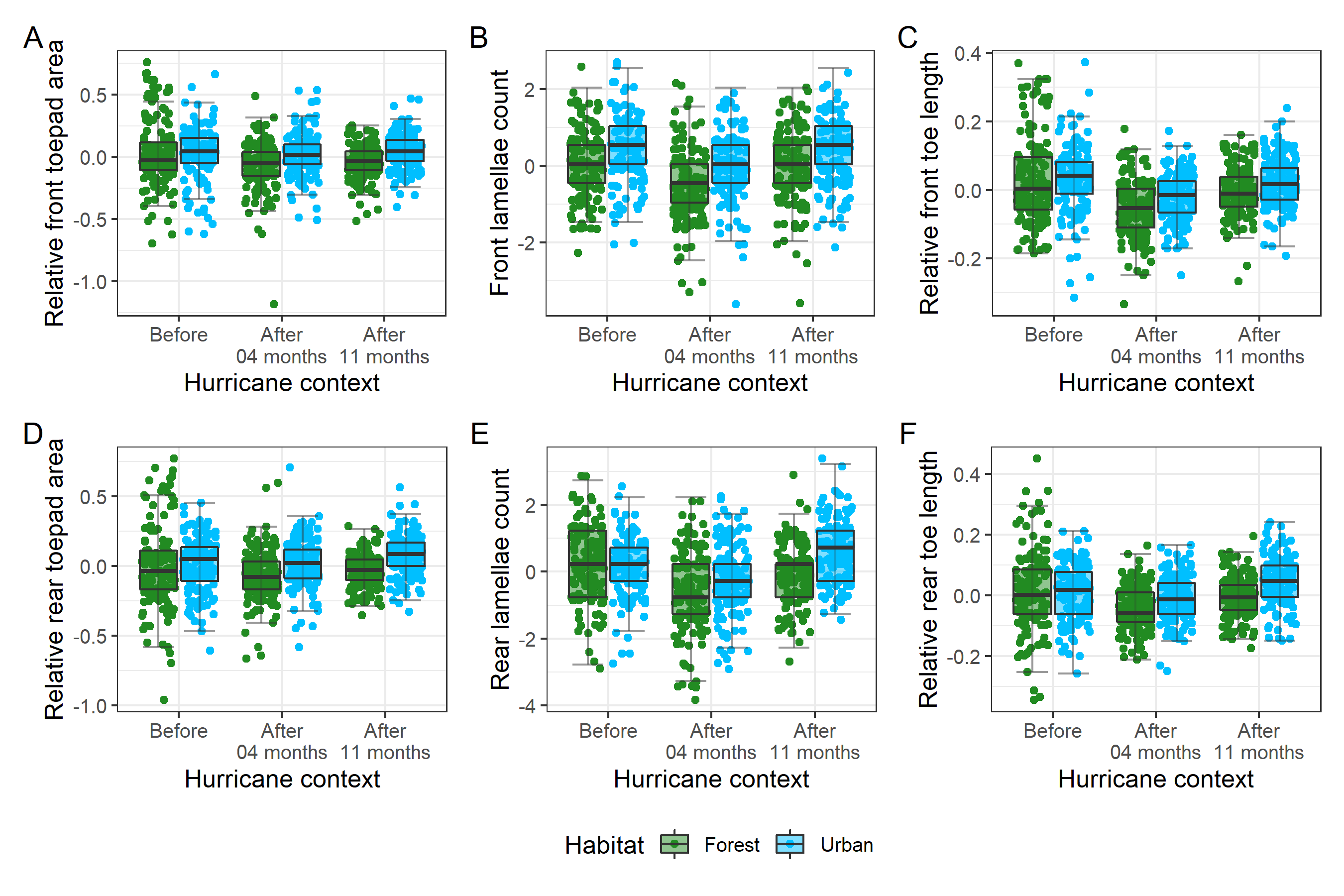Hurricanes in the city
The frequency and intensity of hurricanes are on the rise due to climate change. With many species projected to be affected by rising temperatures, ongoing urbanization, and intense weather events it is critical to understand the potential synergy between these disturbances. For instance, it’s largely unknown how urban species respond to extreme weather events. In 2017, after Hurricane Maria, a devastating category 5 storm, struck Puerto Rico, we began our fieldwork to evaluate this question (Figure 1).

We studied the Puerto Rican crested anole (Anolis cristatellus) for whom we had pre-hurricane morphological data from previous work authored by Kristin Winchell. Because this species lives in urban and forest populations, we could contrast how lizards in both habitats responded to the hurricane. Urban populations of these lizards differ in their morphology from forest lizards of the same species. Urban anoles have longer limbs and broader toepad areas. These traits have been suggested to increase grip strength in several studies and were also found to be prevalent in lizards surviving Hurricane Maria in the islands of Turks and Caicos. Thus, we hypothesized that anoles that survived the hurricane should have longer limbs and broader toepads. These traits are already common in urban anoles, thus we hypothesized that the hurricane might decrease habitat differences in morphology between urban and forest populations.
Post-hurricane lizards were smaller bodied and had smaller traits relative to their body size
We first visited the island of Puerto Rico 4 months and then 16 months after Hurricane Maria, to contrast traits in anoles immediately after the storm and after one year. For our pre-hurricane dataset, we re-analyzed X-ray images and toepad scans collected by Kristin Winchell and collaborators published in Evolution 2017 and ProcB 2018. We found that post-hurricane lizards were smaller-bodied and had smaller trait values relative to their body size. This finding contradicted our hypothesis of longer limb length and broader toepads and did not fully recapitulate the pattern observed for lizards that survived Hurricane Maria in Turks and Caicos. Because morphology largely decreased after the hurricane, the morphological differences between urban and forest lizards did not change.
Urban lizards hold their footing

Although many traits decreased in size response to the hurricane irrespective of habitat, urban toe morphology had largely non-parallel responses to the hurricane in contrast to foreset populations. In fact, urban toe morphology either had non-significant change or a lagged shift towards larger sizes at 16 months after the hurricane. For example, we found that toepad areas and the number of lamellae scales decreased in the forest, but did not change in Urban areas (Figure 2). Broader toepads with more rows of lamellae scales increase the adhesion forces of toepads to surfaces. We believe that toe morphology did not decrease in urban populations due to higher demands of adhesion when using smooth surfaces in urban habitats.

 Compounded effects of disturbances
Compounded effects of disturbances
One year after Hurricane Maria, anole lizards in Puerto Rico had morphology similar to that before the hurricane. This suggests that for this species, the effect of the hurricane was moderate with urban and forest populations recovering after one generation. However, how urban taxa will respond to extreme weather events still remains largely understudied. To accurately predict how ongoing urbanization and climate change will affect species we need to evaluate the potential for these disturbances to compound with each other.
See the full paper here:
Avilés-Rodríguez KJ, Winchell KM, De León LF, Revell LJ. 2021. Phenotypic response to a major hurricane in Anolis lizards in urban and forest habitats. Biol J Linn Soc.:1–16. doi:10.1093/biolinnean/blab011.
Featured Image: “Hurricane Maria 2017 09 20” by anttilipponen is licensed under CC BY 2.0
- New Lit Alert: Cryptic eco-evolutionary feedback in the city: Urban evolution of prey dampens the effect of urban evolution of the predator - December 6, 2022
- New Lit Alert: Unexpected dispersal of Australian brush-turkeys (Alectura lathami) in an urban landscape - November 24, 2022
- New Lit Alert: Activity patterns and behavior of Myocastor coypus in a gated community in the metropolitan area of Buenos Aires (Argentina) - November 3, 2022

Leave a Reply